LESBOS
Religion

Religion

Popular destinations GREECE
| Aegina | Alonissos | Andros |
| Chios | Corfu | Crete |
| Hydra | Kalymnos | Karpathos |
| Kefalonia | Kos | Lefkas |
| Lesbos | Mykonos | Naxos |
| Paros | Patmos | Peloponnese |
| Poros | Rhodes | Samos |
| Santorini | Skiathos | Skopelos |
| Spetses | Thasos | Zakynthos |
Religion
General
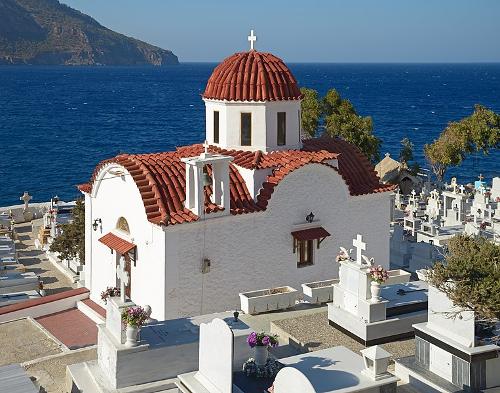 St. Nicholas Church in the Pigadia cemetery, Karpathos, GreecePhoto: Unknown CC 3.0 Unported no changes made
St. Nicholas Church in the Pigadia cemetery, Karpathos, GreecePhoto: Unknown CC 3.0 Unported no changes made
Approx. 98% of the Greek population is members of the Greek Orthodox Church, which arose after the great split in 1054 when the patriarchs from the East no longer recognized the magisterium of the Pope. The Greek Orthodox State Church has been independent from the primacy of the Patriarch of Istanbul (formerly Constantinople) since 1833. The Greek Orthodox Church has a number of differences from the Western Christian Churches. Thus, only the Bible, the Church Fathers and the rulings of the Ecumenical Councils serve as the basis of the teaching. Furthermore, the Greek clergy mainly focus on the liturgy and on prayer and meditation. Socially, the Eastern Church is not nearly as active as in the West. However, the government and the church are much more closely linked. The government subsidizes the Church and the Church in turn follows politics closely.
The largest religious minority are the Muslims, the Turkish Greeks. Most Muslims live in Thrace, where many mosques can be found.
The number of Jews has decreased drastically after the Second World War. In 1941, for example, more than 60,000 Jews lived in northern Thessaloniki; nowadays only approx. 1100. The approx. 40,000 Catholics mainly live on the Greek islands.
Theoctiste of Lesbos
Theoctiste of Lesbos is a saint of the Eastern Orthodox Church and the Community of Eastern Catholic and Latin Catholic Churches. Born on Lesbos, she was orphaned at an early age and in a convent on the island she was raised as a nun until she was 18 years old. At that age she was captured by Saracen slave traders.
During a stopover on the island of Paros, Theoctiste managed to escape and after wandering through the forests of virtually deserted Paros, she found shelter in the ruined temple of Ekatontapyliani. There she would live as a hermit for 35 years and many miraculous events are associated with her life and her relics.
Theoctiste of Lesbos died in the late 9th century and she is commemorated on the 9th and 22nd of November in Eastern Christian churches, and on the 10th of November in the Roman Catholic Church.
Religious buildings
Agios Ioannis Therapondas
Dedicated to St. John of Therapon, this church stands near the pier of the city of Mytilene. It is architecturally a beautiful church, an impressive three-aisled basilica with neoclassical elements and Renaissance elements. Construction of the church began in the early 19th century and was not completed until 1935. The architect of the church was Argyris Adalis, a student of the famous Greek architect Ernst Ziller. The church houses a beautiful collection of icons.
Taxiarchis Mandamados
This church is located near the village of Mandamados, northwest of Mytilene. The church was built in 1700, restored in 1879, and is dedicated to the patron saint of Lesbos, the archangel Michael. The church houses an ancient golden stole and special bibles and other religious books.
Panagia Trouloti
The 14th-century Byzantine church of Panagia Trouloti stands in the village of Thermi, 10 kilometers west of Mytilene. The church houses an 18th-century carved temple, one of the finest examples of post-Byzantine carving on the island.
Monastery of Limonos
The Monastery of Limonos is the largest and most important monastery on Lesbos. It is located 4 km northwest of Kalloni and is open to visitors. Dedicated to the Archangel Michael, this monastery was built in Byzantine times and used until the Ottomans conquered the island in 1462. It was not until 1526 that the monastery was restored as a religious building by Saint Ignatius Agallianos and a church building was attached to the monastery. Saint Ignatius also founded a famous school there, the Limoniada School, the intellectual center of the island until 1923. The monastery now houses an important library with about 5,000 books dating from the 15th century to the present, rare manuscripts, special ecclesiastical objects, sacred icons, jewelry and many other artifacts. The monastery celebrates an important religious festival for Lesvos every year on October 8.
Monastery of Ipsilou
This Byzantine monastery is located 9 kilometers south-west of the village of Andissa, northwest of Mytilene. The monastery was founded before 800 AD in honor of St. John the Evangelist, the author of the book "Revelation. It houses several special ecclesiastical objects, such as stoles embroidered with gold, altar-cloths, valuable crosses and a large number of important documents.
The early Christian basilica of St. Andrew's
The ruins of this three-aisled basilica are located in the village of Eressos, in southwestern Lesbos. The remains of the floors of the church's vestibule and the middle aisle are covered with beautiful mosaics.
Church of Athanasios
Located in the center of Mytilene, the beautiful church dedicated to St. Athanasios has a remarkable structure and dates back to the late 16th and early 17th centuries. It is a cruciform basilica with a dome. The inside of the church is just as breathtaking as the outside, with walls papered with beautiful frescoes, indicating a strong Renaissance influence. The most impressive aspect of this church is its detached large bell tower (33 meters high). Wonderful examples of post-Byzantine carvings include the altar, icon bearer and bishop's throne from 1738. The 16th century icon of Jesus Christ comes from Asia Minor.
Panagia Glykofilousa (Our Lady of the Sweet Kiss)
Built in 1609 as part of a monastery, this church stands in the center of the village of Petra, 55 kilometers northwest of Mytilene. The church is built on a 40-meter-high rock and 114 carved steps lead to the entrance of the church. The church features a very valuable iconostasis carved from wood. This wall of statues that separates the altar space from the nave of the church is also decorated with icons. Also present is a bishop's throne carved from wood. It is one of the most important pilgrimage sites on the island and its fortified position indicates that the church was built during a period of pirate attacks.
Monastery of Agios Raphael
The Monastery of Agios Raphael, one of the most famous monasteries in Greece, is located near the village of Thermi, about 15 km from Mytilene. It is an important pilgrimage site, to which miracles and supernatural phenomena are attributed. Orthodox Christians from Greece, Russia and several Balkan countries visit the monastery every year. The present monastery of Agios Raphael was built in 1963 on the ruins of the former monasteries, and what is special is that the skull of Agios Raphael is preserved there.
Greek mythology
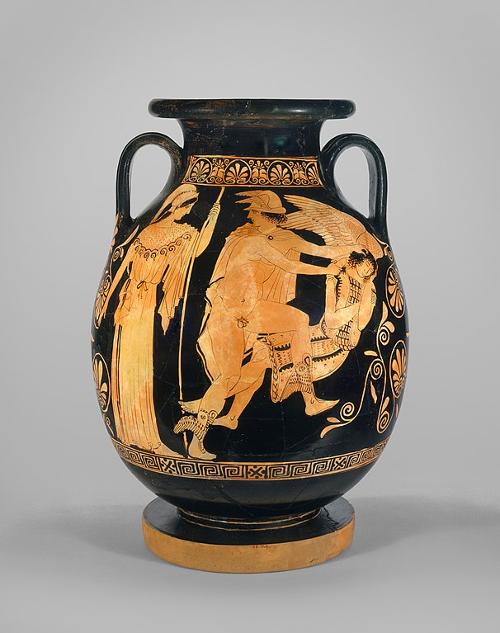 Mythological image on a vase, GreecePhoto: Public domain
Mythological image on a vase, GreecePhoto: Public domain
The word myth is derived from the word "muthos", which first meant utterance and was later often interpreted as "a spoken or written story".
Mythology (muthologia) is thus "telling stories", or a collection of myths, or the study of myths.
When writing originated in Greece, myths and legends were already anchored in oral traditions, and later poets in particular gave the stories a different course. Greek mythology is very similar to other mythologies. For example, the Norse god Odin corresponds to the Greek Zeus and the Norse heroes often performed the same heroic deeds as their Greek colleagues.
Some Greek Gods:
Aeolus (Aiolos)
A son of Hippotes, who was appointed by Zeus as guardian of the winds. He was in charge of the (wind) gods: Boreas, Zephyros, Notos and Euros.
Aphrodite
Aphrodite is the goddess of love and beauty. She was born from the foam of the sea, where the main shrine dedicated to Aphrodite is located. She was married to Hephaestus, but preferred Ares for a lover.
Her son was Eros, the god of love. Aphrodite is depicted with the winged Eros and with doves. She was one of the Olympian gods. The Romans called her Venus.
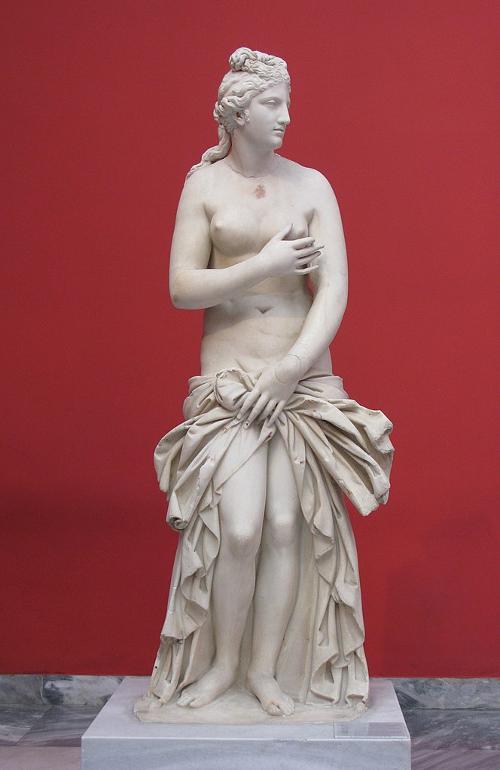 Aphrodite, goddess of love and beauty, GreecePhoto: Tilemahos Efthimiadis CC 2.0 Generic no changes made
Aphrodite, goddess of love and beauty, GreecePhoto: Tilemahos Efthimiadis CC 2.0 Generic no changes made
Apollo
Apollo was the son of Zeus and Leto, and the twin brother of Artemis. He is god of light, of medicine, music and science. Apollo is often depicted with a lyre in his hand. The main shrine dedicated to Apollo is located in Delphi, the most important oracle site of ancient Greece. Apollo was an Olympic god.
Ares
Ares was a son of Zeus and Hera and is the god of war. He is often depicted in full armor and was an Olympian god. The Romans take him Mars.
Artemis
Artemis was Apollo's twin sister and daughter of Zeus and Leto. She was the goddess of nature and the hunt. She was also the tutelary goddess of pregnant women and is often depicted with a bow in her hand. She was an Olympian god and her Roman name is Diana.
Dionysos
Dionysos was a son of Zeus and god of grapes and wine. He is often depicted with a staff that is wrapped at the top with ivy leaves. He was an Olympian god and his Roman name is Bacchus or Liber.
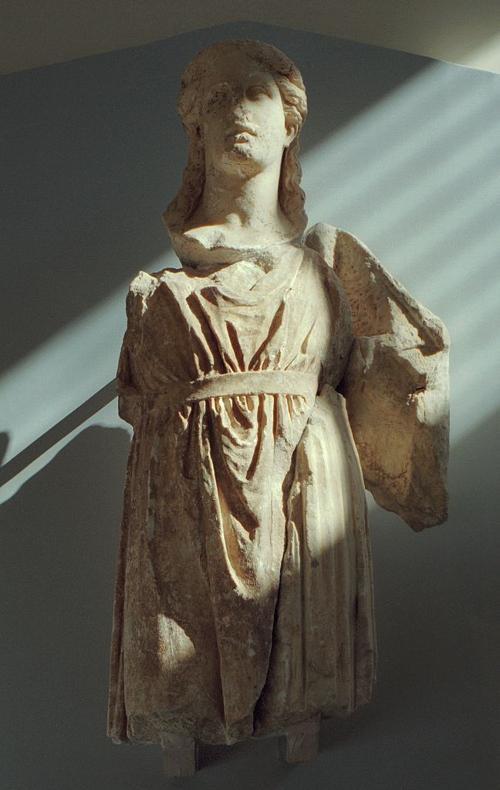 Dionysos, GreecePhoto: Zde CC 4.0 International no changes made
Dionysos, GreecePhoto: Zde CC 4.0 International no changes made
Eros
Eros is the god of needs and is also called Himeros. Eros is often seen as a winged boy god who shoots men in the heart with love arrows. Roman names for him are Amor and Cupid.
Hermes
Hermes was the messenger of the gods and a son of Zeus. He is also god of travelers, thieves, and merchants. He is always depicted wearing a traveler cap and staff or a helmet with wings. His sandals also have wings. He escorted the ghosts of the dead into the underworld, Hades.
Pallas Athena
She is the daughter of Zeus only, because born from his forehead. She is the patron goddess of the artists and craftsmen, but also the goddess of wisdom and knowledge. In wartime Athena was also worshiped as a war goddess. She was the special guardian goddess of the city of Athens and a guardian angel of Greek heroes such as Heracles and Odysseus.
She is often depicted wearing a helmet and full armor. The owl, which symbolizes wisdom, was devoted to her. Pallas Athena has a sanctuary located in Athens: the Parthenon. She was an Olympian god and her Roman name is Minerva.
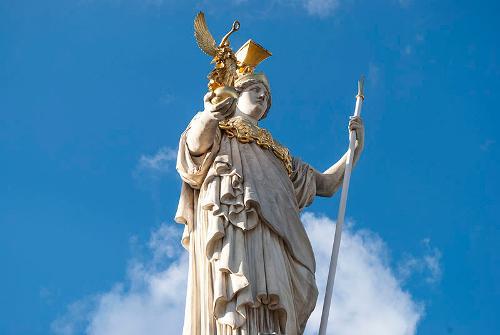 Pallas Athena GreecePhoto: Diana Ringo CC 3.0 Austria no changes made
Pallas Athena GreecePhoto: Diana Ringo CC 3.0 Austria no changes made
Poseidon
Poseidon is a helm of Zeus and is the god of the sea and guardian god of the sailors. His palace is deep under water and he is often depicted with a trident, with which he can stir the sea. The horse was dedicated to him.
Because the Greeks believed that the land floated on the sea, they also considered him the god who caused the earthquakes. The Roman name is Jupiter.
Zeus
Zeus was the supreme god of the Greeks and the king of gods and men. He was also the god of the sky and the weather. He is often depicted with a lightning in his hand and is seated on a throne. Many demigods and heroes, such as Hercules and Perseus, arose from his love affairs with beautiful women.
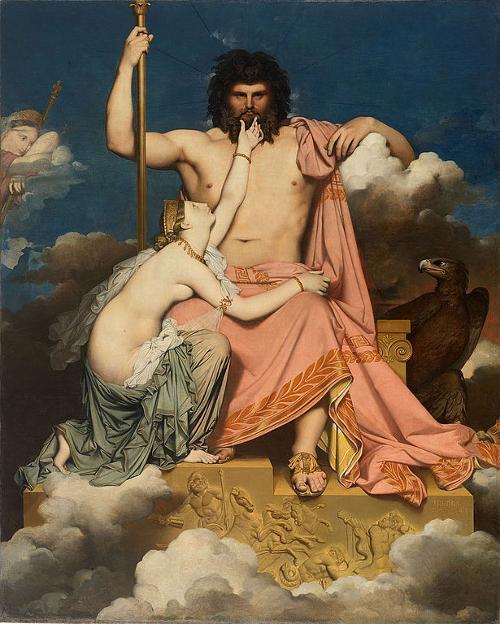 Zeus and Thetis, GreecePhoto: Public domain
Zeus and Thetis, GreecePhoto: Public domain
Sources
Dubin, Marc S. / Griekse eilanden
Van Reemst
Greek islands
Lonely Planet
Griekse eilanden
Lannoo
McGilchrist, Nigel / Greece : the Aegean islands
Somerset Books
Midgette, Anne / Griekse eilanden : Egeïsche Zee
Het Spectrum
CIA - World Factbook
BBC - Country Profiles
Copyright: Team The World of Info